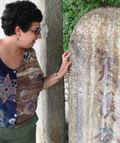
 Government, for better or worse, hasn't changed all that much in two millennia.
Government, for better or worse, hasn't changed all that much in two millennia.
China's government 2,000 years ago confronted the same kinds of problems as their modern counterparts — making decisions that are limited by incomplete information in times of factionalism.
This insight comes from UC Merced history Professor Ruth Mostern's book “Dividing the Realm In Order to Govern: The Spatial Organization of the Song State,” published earlier this year by the Harvard University Press. The book shows how UC Merced’s faculty members are addressing modern day problems through novel research.
“Governments never know everything they should for good decision making. They are often incredibly ambitious and have few resources,” Mostern said. “Decisions come not only from power but from chaos and confusion.”
The book draws information from a comprehensive database envisioned by Mostern and designed by student Elijah Meeks, who now works at Stanford as a digital humanities specialist. The database chronicles the changes made by the Song Dynasty to the towns, counties and prefectures during medieval China. Mostern studied the database to determine periods of major changes and of stability in the 300-year dynasty.
“This is really a whole methodology that's barely been used before,” Mostern explained. “I am optimistic the book will be able to help develop a new direction of thinking about geography and state power.”
Most often, historians read documents and write about what they find. In medieval China, there were few documents in existence, but troves of bureaucratic data created by the government.
Mostern was surprised to see stability in the urbanized areas, as she thought the commercial hubs would be ever-changing. The government made major changes to the empire’s periphery, which was being colonized.
The digital assets division of the UC Merced Library is hosting the database online. The Digital Gazetteer of the Song Dynasty is open, allowing other scholars to run queries and answer other questions about the dynasty.
Mostern will continue her work about China this summer as she begins a project about the Yellow River. The American Council of Learned Societies recently awarded Mostern a Digital Innovation Fellowship meant to further her innovative approach to history. The fellowship, both competitive and prestigious, will pay for a year’s salary and project costs, allowing Mostern to focus on the project.
“The State of the River” will be a comprehensive history of the river, which has had a profound effect on Chinese history and society. The Yellow River, the most silt-laden river in the world, was responsible for more than 1,000 floods during the imperial era. It also changed course more than 30 times.
Mostern’s hypothesis is that increases in silt deposits — which raised the river bed — was caused by the degradation of grasslands upstream as that area was colonized. The project will include research from other disciplines, such as hydrology, geosciences and geomorphology.
The longterm findings of how China has managed its water system for 2,000 years will lend insight into California’s water woes, which in comparison are less than 200 years old.
“There are big picture things we can’t see because we’re living through it. There are things that just aren’t visible to us,” Mostern said. “Anyone interested in sustainability should want to pay attention to this project.”






